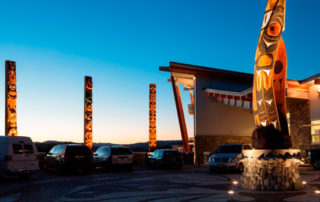-
FNTC: NEWS
Songhees Wellness Centre: a Community’s Dream Come True
A shining example of how First Nations are learning to prosper with tax jurisdiction.
Thirty years ago the Wellness Centre was a community dream, eight years ago a Songhees Committee started the process of making the dream a reality, and on January 22, 2014, the Songhees Nation celebrated the grand opening of their long-awaited Centre. The Songhees Nation, located on southeastern Vancouver Island near the City of Victoria, had first conceived of building a gym to house after-school and evening activities for the youth.
In 2005 the Songhees Nation and the Government of Canada settled the Rail Spur Claim, and the Songhees Council was able to set aside funds to begin the process of planning for their gym.
At that time, a community committee was formed to research and plan the facility. The committee and the Council collected the ideas with the guideline “if we could have anything we want, what would it look like?”
Songhees has a limited land base and its government was operating out of a number of different buildings. The community wanted a facility where all of the programs and services could be housed in one location. They wanted a gathering place for all community members, from children to elders, as well as the ability to offer sports training, job training and arts and culture programs.
The Community came together and was very proud of the resulting plan. It included all of the aspects they felt the community required to thrive.
Songhees applied for government funding for the facility, and received only $1m out of the $24m required to build. Songhees began to think out of the box and, not wanting to diminish the community’s vision, came up with a strategy to fund the building on their own. Songhees implemented the First Nations Goods and Services Tax (FNGST) and entered into a revenue sharing agreement with Canada. That revenue stream, along with a lease agreement, was enough to securitize a long-term loan.
During this process, Songhees was working with the First Nations Tax Commission on implementing the First Nations Fiscal Management Act (FMA). In 2008, Songhees became the first First Nation in Canada to pass taxation and assessment laws under the FMA (they initially began collecting property tax under the Indian Act in 1995). Songhees is certified by the First Nations Financial Management Board, is a borrowing member of the First Nations Finance Authority as has passed a Financial Administration Law.
The Songhees Nation and its Wellness Centre is a shining example of how First Nations are learning to prosper outside of the Indian Act and government funding. Songhees credits the success to community involvement and support from the First Nation fiscal institutions.
Songhees invites those interested in learning more about the Centre and how they completed this project to contact them: https://www.songheesnation.ca/
Loon River First Nation: Vital Service Delivery to Community and Taxpayers
When contemplating the implementation of property tax jurisdiction, First Nations think about how the community may benefit from the program. Loon River First Nation’s experience represents an example of how the community and taxpayers have both supported and benefited from the additional community services made available through their property tax program. First Nations across the country are looking to see how other First Nation governments are applying their jurisdiction. Loon River First Nation is a leader in this regard.
Loon River First Nation (LRFN) is located 170km north of Slave Lake, Alberta. LRFN is part of Treaty 8 and has a total land base of 21,096.3 hectares spread over three settlements: Loon Lake 235, Little Prairie 237 and Swampy Lake 236. LRFN offers a full range of services to its 540 members including Administration, Economic Development, Daycare, Consultation, Finance, Human Resources, Membership, Education K-12, Emergency Management, Housing, Health, Social Services and Public Works.
Northern Alberta, where LRFN is located, has significant oilfield and gas production, related process facilities and pipelines. A large part of the LRFN tax base is made up of these properties held by various industry companies. The driving force behind wanting to implement property taxation, which LRFN did in 2007, was the need for a reliable water source and associated infrastructure. The tax dollars assisted in delivering this much needed service.
In 2010, a house fire on the reserve demonstrated the unfortunate inadequacies of fire protection services available to LRFN at that time. The home was burnt down and a family required emergency shelter. LRFN Council took immediate steps to look into how they could update their fire protection services and decided to implement this important and life-saving service through property taxation. As part of their financial planning, with assistance from the First Nations Tax Commission, LRFN proposed an additional tax levy for a five-year term to help finance the necessary equipment.
Taxpayers were advised of the dire need and were asked to support the initiative and the additional levy on their tax bill. There was immense support from taxpayers, industry and the community. The taxpayers, who benefitted from the new services, agreed and shouldered the additional costs without any objections to support the First Nation. LRFN Council was proactive and addressed the safety concerns for a safer community. With the additional funding, LRFN built a fire hall, purchased one fire truck and trained seven fire fighters.
In the Spring of 2011, the hot and dry weather sparked devastating forest fires that swept throughout northern Alberta. All available resources were pulled together and organized by the local municipal authorities in an effort to combat the worst fire emergency in decades. Homes in the community were endangered and all oilfield facilities in the outlying areas were at high risk. The Loon River First Nation fire pumper truck was part of the flotillas of equipment that battled the fires.
Due to the financial planning and subsequent emergency preparedness planning from the previous year, the community and by extension the taxpayers, were protected from the wild fires. The new fire protection services contained and prevented the spread of the fire to community and industry assets. Since the fires in 2011, LRFN has increased trained firefighters to twelve and has added more equipment including a sewer truck, a grader, skid-steer, garbage truck and a backhoe.
The experience with the fire and LRFN response has strengthened the relationship and trust between Loon River and its taxpayers. The taxpayers are happy with the level the service and are open to improvements in service deliveries. In addition to the fire protection service, the community has plans for using taxation revenue to help play for installing a piped water line from a reliable source. This important water source will open the door for future developments such as a new recreation centre, a skate park, a ball diamond, expansion of the fire hall and an additional fire truck. Visit the Loon River First Nation website for more information: www.loonriver.net
FNTAA’s Vision to Promote First Nation Tax Profession
<

